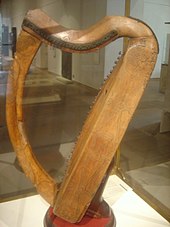Queen Mary Harp
55°56′49″N 3°11′20″W / 55.947°N 3.189°W
This article possibly contains original research. (May 2012) |

The Queen Mary Clàrsach na Banrìgh Màiri or Lude Harp, is a Scottish Clarsach currently displayed in the National Museum of Scotland[1]. It is believed to date back to the 15th century, and to have originated in Argyll, in South-West Scotland.[2] The Queen Mary harp is a very rare and valuable survivor, as one of only three Gaelic harps to survive from medieval times, the others being the Lamont Harp and the Trinity College harp. About 15 more survive from between 1500 and 1800 AD[original research?].
History
The Queen Mary harp [3] was presented to Beatrix Gardyn by Mary, Queen of Scots, in the 16th century, and was subsequently passed down into the Robertson family of Lude, in Perthshire. Lady Gardyn's son had a servant in 1588 called Anthony McEwan McChlairser - 'son of the harper' - which provides a clue as to who might have played this clarsach.[4] The last harpist to play the instrument is dated as John Robertson of Lude who died c.1729; his repertory was preserved in the family and published by John Bowie in 1789. All three surviving Gaelic harps are considered to have been made in Argyll in South-West Scotland sometime in the 14th-15th century.[2]
Appearance

The Queen Mary harp is noted for being the most complete and best-preserved of all the old harps. It is covered in original and intricate carving, The forepillar or (Lamhchrann) is elaborately carved with a double-headed fish and the instrument retains, clear traces of its original paint[original research?]. The decoration includes a number of pieces of Christian symbolism suggesting that the harp may have been made as a commission for a church or monastery.[5] The vine-scrolls and the particular shape of the "split palmette" leaves have clear parallels with 15th century West Highland grave slabs from the Argyll area, suggesting that this is the time and place that the harp originated.[2] A grave-slab in the chapel at Keills in Knapdale has a carving of a clarsach similar to the Queen Mary Harp[original research?][not specific enough to verify].
Replicas
This section contains promotional content. (May 2012) |
Replicas of both the Lamont and Queen Mary [1] Harps with gold and silver wire strings are played by harpists and built by David Kortier[6], based on his measurements from the original to reproduce its idiosyncratic string spacing, angles and overall ergonomics[original research?]. Student replicas are available from the Historical Harp Society of Ireland. The most accurate replica was made by Roscommon sculptor Davy Patton[7] and is played by Simon Chadwick; it can be heard on his CD Clàrsach na Bànrighe
Recent Study
This section contains promotional content. (May 2012) |
The Queen Mary harp, along with the Lamont harp also preserved in the National Museum of Scotland, are currently under study by Edinburgh University PhD student Karen Loomis[8]. Loomis has imaged the Queen Mary harp using a CT scanner [9]. Her MMus thesis covered damage and repair to the Queen Mary and Lamont harps [10].
References
- ^ http://www.nms.ac.uk/queenmaryharp-fullwidth.aspx
- ^ a b c Keith Sanger and Alison Kinnaird, "Tree of Strings - Crann nan Teud", Kinmor 1992
- ^ "National Museums of Scotland - Clarsach associated with Mary, Queen of Scots". Nms.scran.ac.uk. Retrieved 2012-04-02.
- ^ "National Museums of Scotland - Detail of a clarsach associated with Mary, Queen of Scots". Nms.scran.ac.uk. Retrieved 2012-04-02.
- ^ Robert Bruce Armstrong “The Irish and Highland Harps” 1904
- ^ "David Kortier-Harpmaker". Kortier.com. 2012-01-25. Retrieved 2012-04-02.
- ^ "Davy Patton • Early Irish Harps". Davypatton.com. Retrieved 2012-04-02.
- ^ "Overview | Postgraduate profiles | Music". Ed.ac.uk. 2010-09-16. Retrieved 2012-04-02.
- ^ Wire Strings, the newsletter of the Wire Branch of the Clarsach Society, October 2010, p.9
- ^ Karen Loomis, The Queen Mary and Lamont harps: A Study of Structural Breaks and Repairs. MMus thesis, University of Edinburgh, August 2010
